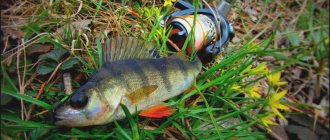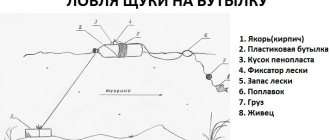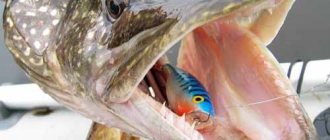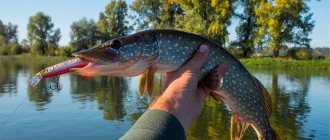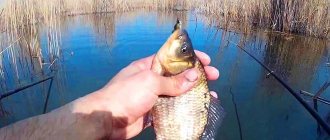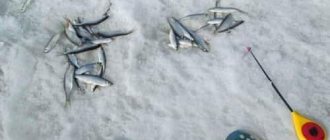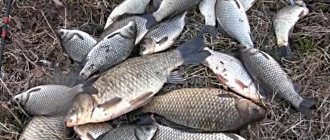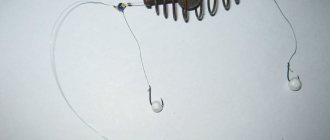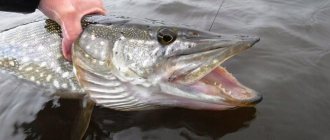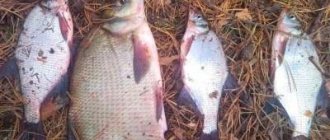Features of spinning fishing in spring
In the spring, in the regions of Russia, bans on fishing with spinning rods, which usually work in natural reservoirs during spawning, begin to apply. Therefore, before going fishing, you need to check when and where it is prohibited. Otherwise, you may run into trouble in the form of heavy fines and confiscation of your catch. If you plan to fish on paid reservoirs, the problem does not arise. As a rule, there are never any restrictions on them.
You should be well prepared for fishing in the spring. At this time of year, the weather is unpredictable, and warmth can quickly give way to cold wind and rain. It is necessary to choose equipment so as not to suddenly freeze or get wet. It is advisable to wear a waterproof suit and warmly lined waders. It won’t hurt to wear thermal underwear, a sweatshirt, a hat made of waterproof material and take the same mittens with you.
How to equip a spinning rod for pike
If you are going to catch pike with a spinning rod, you should choose the right gear. The spinning rod should be 2.5-4 meters long. It is desirable that it has a soft tip. It makes it easier to control the bait. For standard fishing with a medium-sized jig, you can use a spinning rod with 5-25 or 10-30 gr. Smaller or larger tests are suitable for specific baits and more experienced fishermen.
Catching pike with a retractable leash is an equipment often used for jig fishing.
Which spinning rod is the best?
It is advisable to purchase a spinning rod from well-known, trusted manufacturers. Such products are more expensive, but they naturally have a different level of quality. This spinning rod is very durable and can serve for many years. If you can't afford such a purchase, take the middle class. In general, the differences in fishing will be insignificant.
Coil
The spinning reel is selected depending on the fishing conditions.
You should not buy a baitcasting reel, as you will get tired of untangling beards - this is not an option at all for catching a toothy predator. A medium-sized spinning reel is perfect for pike fishing. It is also advisable to take care of a spare bobbin.
fishing line
It is important that the line goes without any problems, easily and simply. The reel should be wound with monofilament, the thickness of which should be approximately 0.25 mm - this is the optimal size for pike. Thicker lines can spook fish, and thin lines aren't as strong.
When fishing with spinning rods, anglers are increasingly giving preference to braided fishing line - it is more reliable. The disadvantage of such a fishing line is its price, as well as some physical features that can lead to cuts if handled carelessly during wiring.
Lures
In March, pike can be caught using a variety of baits (jigs, spinners, wobblers). This is the period when there is a lot of caviar in the belly of the predator, so large baits do not attract it. If the size of the bait is more than 5 cm, the pike simply will not be able to swallow it. For fishing in the second half of spring, when spawning has not yet passed, you should take the smallest baits.
The video below shows spinning lures used to catch large pike .
Choosing lures for pike fishing with a spinning rod is a wonderful detailed guide to choosing bait.
If you are a beginner, then stock up on a standard set of baits, among which you will have something to use when fishing and evaluate the catchability of the equipment and its attractiveness to a predator:
- Three rotating spinners.
- Three oscillating spoons.
- Five medium twisters with 10-15 gram jig heads.
- Five silicone vibrating tails.
Through experimentation, you should choose the size and color of the bait. Pike can behave unpredictably in different conditions, so you need to act according to the circumstances.
Types of fish for spinning fishing in spring
In the spring you can catch:
1. Pike. After the ice melts, the predator goes to shallow water, where the water warms up faster, and before and after spawning, the fish begins to eat heavily. She greedily grabs any bait.
2. Pike perch. In spring it is not very active, but can bite well in winter mooring areas and in places with uneven bottom topography.
3. Perch. This predator falls for small baits. Small and medium-sized specimens gather near the shore in the spring to feed on the eggs of other fish, and can enter spills. Large perches appear in the coastal zone in late April - early May. Before this, they need to be caught with long-distance casts.
4. Chub. It becomes active two weeks after the ice melts and moves to spawning grounds. Fish can be found in tributaries, near river mouths. In April, small chub concentrate near the shore, near bushes and hanging tree branches. Large individuals stay 20-30 meters from the coastline.
5. Asp. Before spawning it must be looked for at great depths, after - in shallow water. Asp rarely approaches the shore and actively bites at a decent distance from it in the second half of spring. The zhor stops during the spawning period, which lasts only a short time at different times from the last days of April until the water in the reservoirs subsides. It is caught using jig baits and wobblers.
Where and when to fish with a spinning rod in early spring
When choosing the time for spinning fishing in early spring, several factors are used.
A good bite can be expected on a sunny and windless day, if there has been no precipitation on the previous few days. Rains preceding the date of the planned fishing can lead to a rise in the water level (which, in general, is not catastrophic) and cloudiness (but this is bad). At this time of year, fish are looking for clean, oxygenated water. Based on this, in addition to standard habitats (edges, holes, pools near the current, snags, dumps after rapids) and the points where streams flow into rivers or water inlets from flowing lakes, they include in promising fishing areas.
It is also necessary to fish for cascades and small waterfalls (if any are observed), because this is where the water is saturated with oxygen. Points of mixing of clear and turbid water flows may be very promising places. Often good fishing spots can be identified by circles in the water, which indicate that the fry are walking. And where the fry is, there should be a predator nearby. Another unwritten rule says: small fish are caught in shallow water, and trophy exhibits are hunted in depth.
When can you start spinning fishing in the spring?
The success of spinning fishing in the spring depends on the characteristics of the reservoir and the behavior of a particular fish, which differs among different breeds. When can you start fishing based on these conditions?
1. Pike. The predator can be caught after the first gullies appear in bodies of calm water. In rivers, ice breaks first in areas with strong currents. There are no pike on them. Toothy is waiting for places with holes and reverse flow to open up.
2. Pike perch. It is actively caught using a spinning rod only after the ice has completely disappeared from the reservoir. The pike perch begins to bite well earlier, but floating ice floes make it difficult to cast the bait far, to carry out the retrieve correctly, and to get to the fish’s mooring areas by boat.
3. Perch. He begins to greedily hunt for bait immediately after the appearance of gullies created by melt water. Closer to spawning, the predator bites poorly.
4. Chub, asp. This fish is difficult to catch until the water warms up to a temperature of +9ºС. At the beginning of spring, it stays at great depths and rarely pays attention to bait. Then, as the water warms up, it moves to shallow water or to the shore.
Choosing the right place

A successful catch and interesting fishing primarily depends on the correct choice of place for fishing.
Fishing for perch in early spring using spinning rods is carried out at the very bottom of reservoirs. In March, the fish prefers to stay at depth, since the upper layers of water are not yet warmed up enough. The best places for fishing for perch at this time will be areas of reservoirs at the bottom of which there are snags, fallen trees, and near bridges . In artificial ponds, it is best to look for perch in areas with a sharp change in bottom depth.
Places for pike fishing in March are determined depending on weather conditions. On sunny days, pike stay near the surface of the water , where they look for food. In cloudy weather, pike are usually active, but are under the ice, so catching them with a spinning rod in the morning is quite difficult. Closer to noon, the fish approaches the shore, and you can catch it at a depth of about three meters.
In March, when daytime water temperatures gradually increase, pike perch move to smaller areas of the reservoir. It lives in places where streams and meltwater flow into the river. In early spring, pike perch can be caught at a depth of up to two meters.
Carp, in search of food, rushes to shallow water, to the coastal zones of the reservoir. The best place for fishing for this type of fish will be shallow areas of rivers, lakes and ponds, where the water is sufficiently warm. The absence of vegetation at the bottom of the reservoir increases the chances of catching this type of fish.
Bream bites well in the coastal zone on channel edges, as well as in bays where the water is fresh and enriched with oxygen at this time. In early spring, bream can be caught well at a depth of two to four meters.
Features of reservoirs
Fishing in different bodies of water begins at different times, which is regulated by the speed of the current, the level of water rise, and the types of flood.
1. Small rivers. The water level in them rises by 30-50 centimeters and quickly decreases. You can start catching pike a week after the ice melts.
2. Big rivers. In them, water rises to a height of up to two meters during ice melting and can flood the coastal coastal zone. In this case, you need to hunt for pike before the flood, as it will make the water cloudy.
3. Lakes. The water level in them in spring depends on the number of tributaries and the volume of snow that lies on the shore. The water in lakes does not rise as much as in rivers and quickly becomes clear. Fishing with a spinning rod can be successful immediately after its level decreases.
Fishing from a boat
To catch pike from a boat, you can use fishing devices that are suitable for fishing from the shore. Fishing from a boat is done by placing bait. This is a rather complicated process. For fishing in small bodies of water, small swimming devices should be used. If you find a school of white fish using your echo sounder, you can be sure that the catch will be large, since pike usually feed near such schools. You can also try fishing for pike in the bottom area, especially in places where there are a lot of irregularities. If there is little activity, you can try fishing with wobblers with rattles.
Fishing from a boat and from the shore using a spinning rod in spring
In early spring, in large bodies of water, fishing from the shore is the most promising. It is more convenient and safer to approach fish habitats from there. This:
1. Hollows on rivers.
2. Non-freezing areas.
3. Ice-free areas in ponds with standing water.
For fishing from the shore, fast action forms with a length of 2.2 meters to 2.8 meters are suitable. Fishing from a boat becomes available after the ice has completely disappeared. Light and ultra-light spinning rods with a length from 1.8 meters to 2.4 meters with a fast, medium, parabolic action are suitable for it.
Shore and boat fishing
In early spring, fishing from the shore can often be more promising than boat fishing , since water bodies are not yet completely free of ice and you can only get to an attractive place along the coastline.
Such promising places could be:
- gullies on the river;
- thawed coastal areas in stagnant bodies of water;
- sections of rivers that do not freeze in winter.
Boat fishing becomes possible when the ice is almost completely melted , and then the spinning angler gains advantages, since he can reach places inaccessible to the “shoreman”.
How to choose equipment for spinning fishing in spring
Equipment for spinning fishing in the spring is selected taking into account the type of fish that you plan to catch.
1. For pike hunting. To catch predators, you will need a medium action spinning rod with a weight of 2 grams to 30 grams. The rod is equipped with a powerful reel ranging in size from 2500 to 3000 with a front friction brake, a durable braided cord, and a metal leash.
2. For fishing for pike perch. Hunting for this fish is usually carried out using a jig. You need a quick formation form with a test depending on the depth and current speed. A reliable spinning or multiplier reel is mounted on it, a braided cord and a fluocarbon leash are tied if fishing is carried out on snags and rock-filled reservoirs.
3. For perch fishing. Light fast-action blanks with dough from 2 grams to 14 grams, reels with sizes from 500 to 1000, monofilament or braided cord with a diameter of 0.08 millimeters to 0.16 millimeters are suitable for it.
4. For catching asp and chub. In this case, the most convenient will be universal spinning rods of ultra-fast and fast action with tests reaching 15 grams in early spring, and 30 grams in the period after spawning. Reels of size 2500-3000 are placed on them and monofilament is attached. Braided line is not used when catching this fish.
Spinning rod installation
For pike fishing
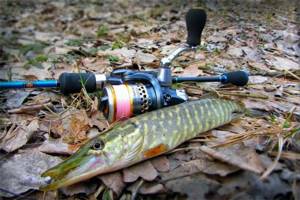
Pike fishing tackle includes the following elements:
- Rod. Carbon fiber spinning rod with a test of 2-25 or 10-30 medium action, i.e. A fairly versatile rod that can be used to fish in almost any conditions.
- Coil. Any decent reel size 2500-3000, preferably with a front drag.
- Fishing line. A braided cord with increased wear resistance, since in spring the water is saturated with small abrasive particles.
- Leash. A metal leash is always necessary when fishing for pike, especially since in fairly muddy water there is no point in using an expensive fluorocarbon one.
For catching pike perch
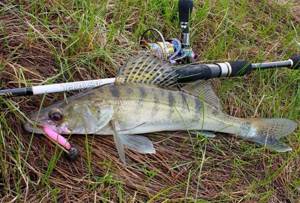
Catching pike perch in the spring almost always involves jig fishing, so the following kit is needed:
- Rod. Fast action spinning - longer for shore fishing, and shorter for boat fishing, with a test that depends on the depth at the fishing site and the strength of the current, if present.
- Coil. Reliable spinning reel or multiplier.
- Fishing line. A braided cord with increased wear resistance with a fluorocarbon leash attached to it, if the bottom of the reservoir is replete with various obstacles.
For perch fishing
For perch, all gear should be of a lighter class.
For catching white predators
It is better to use a universal rod for catching chub or asp, since it is not known in advance whether you will have to use wobblers or fish with jig baits.
Lures for spinning fishing in spring
Lures for spinning fishing in the spring should be selected based on the fishing method and type of fish.
1. Jig. It is used when hunting a predator lurking at the bottom. The most popular jig baits are twisters, vibrotails, and silicone worms. There are reservoirs in which spawning lamprey appears in the spring. Its imitations are of great interest to pike and zander. When fishing before spawning, baits should be large, and after spawning – small.
2. Wobblers. They are suitable for fishing for pike in shallow water, in areas overgrown with underwater plants. In March-April, the predator attacks large, actively playing minnows, jerkbaits, and crankbaits; in May, after spawning, it bites on slow-playing minnows. Wobblers are an excellent option for catching chub and asp near the shore. They can simply be set adrift in areas that are attractive for fish.
3. Spoons. They will be the best choice for catching predators in shallow water and in thickets. Heavy spinners provide precision long casts. It is important that their petals can play well. Small spoons can be used when hunting pike, pike perch, asp at depth or on rivers with strong currents. In early spring, you need to choose bright, aggressively colored spoons; closer to summer, silver or greenish baits.
Lures are selected taking into account the preferences of the fish before and after spawning. At the beginning of spring, pike bite well on spinners, perch on vibrotails and twisters, pike perch is interested in foam rubber, chub and asp prefer wobblers.
Wiring for spinning fishing in early spring
There are different methods of conducting, but all of them are united by the pace: it should be slow, calm, bordering on a complete stop.
Pike fishing tactics in spring
The conclusion in the light of all that has been said is that spring pike fishing with a spinning rod is unpredictable. By choosing the right body of water and where to fish on it, the angler significantly reduces the possibility of an unsuccessful fishing outcome. Even better, don’t just fish with a spinning rod as you have to, but carefully think through some kind of plan in your head. At least for the initial stage of fishing, and then – how it goes.
The tactical pattern of a fisherman’s actions when fishing from the shore and from a boat is different. In the first case, you can fish only from certain approaches, in the second, it opens up the possibility of fishing with a spinning rod in the most promising places that cannot be reached in any other way.
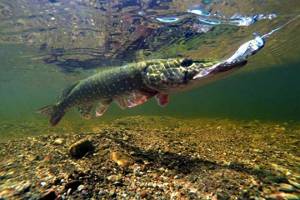
From the boat
Having a boat makes a fisherman's life much easier. Firstly, the entire water area of the reservoir becomes available for fishing. On the boat you can become especially comfortable for casting and retrieving bait. Secondly, the consumption of baits when hooked is greatly reduced. However, you can only use watercraft until there is a spring spawning ban.
The question of where to look for pike in the spring on the river disappears on its own - with a boat you don’t need to break through the wilds - we just swim to the border of the bay with the reeds and fish from the open water. We gradually pass through all the promising places, stopping longer at the most interesting ones. Pike do not bite all day in the spring - there are also timed outings and peaks of activity. Therefore, it is useful to fish the most promising water areas with a spinning rod later.
In some places, the pike bite in spring begins in the early morning - this is rather closer to summer. In others it’s already light, as is usually the case at the beginning of spring. Whether the pike is active or not will be determined by the first hour of fishing; further tactics and selection of bait will depend on this. However, an active exit can occur at any time - then aggressive retrieves and baits will work better.

Catching pike in the spring with a spinning rod from the shore
On small rivers, fishing for pike with a spinning rod in the spring with enough approaches to the water does not require a boat. The point here is to check as many promising places as possible in a day. If a body of water has been accurately studied, as well as the preferences of the pike in it, it is advisable to quickly pass through and cast a spinning rod at known promising points with bait that has already worked well there recently.
When using wobblers to catch pike on a spinning rod from the shore in the spring, you need to be careful - an increase in the water level can simply hide branches and snags from view. It is better to look for pike in the river with a jig or spinners without hooks, and throw wobblers only in obviously clean places.
In both cases, both from a boat and from the shore, it is important to take into account the seasonal characteristics of the behavior of pike in the spring, and take them into account in the tactics of action on the reservoir.
Spinning fishing techniques and tactics in spring
Spinning fishing techniques in the spring differ from fishing at other times of the year only in the peculiarities of the fishing. During the period after the ice melts, they should be smooth and slow. A fast moving bait can scare away sleepy and lethargic fish. As summer approaches, the speed of posting increases. They can be:
1. Uniform. The line is wound onto the spool evenly, without changing the number of movements. They work only with a reel, keeping the spinning rod in one position. The speed of the retrieve depends on the depth of the bait. This method is used when fishing in the middle layers of water and near the surface.
2. Uneven. In this case, the line is wound at a variable speed. The bait should float, sink, and move chaotically. To make her play more active, twitch the tip of the form up, down and to the sides.
3. Stepped. After casting, wait for the bait to fall to the bottom. The fishing line is reeled in so that the bait rises 40-50 centimeters, stands, then drops 40-40 centimeters, then rises again, and so on. The spinning rod is moved down, up, and to the sides. This type of fishing with floating wobblers is the most effective when catching a sleepy, lethargic predator.
4. Ryvkov. Such wiring is suitable for twitching with poppers and minou. Spinning is used so that the bait actively moves from side to side. They regularly pause and jerk while reeling in the fishing line. When hunting for perch, you need a small amplitude of oscillations of the bait; for pike and pike perch, wide and sweeping oscillations are needed. The softness of the retrieve and the length of pauses between jerks depend on the behavior of the fish. The more active the predator, the harsher the wiring and the shorter the duration of pauses. To implement the jerk method, you need a short spinning rod with a braided cord. Monoline does not allow you to animate the bait well.
5. Pendulum. Such wiring is suitable for snags, ponds overgrown with underwater vegetation, littered with trees, and for rivers with fast currents. After the bait falls to the bottom, the spinning rod is placed in a horizontal position and pulled up 10-15 centimeters. The bait should rise. The idea is to move the rod 5-10 centimeters forward so that the bait falls to the bottom again.
Lures
Jigs
Jig baits are a priority when fishing for pike perch. In addition to the usual twisters and vibrating tails, success can be achieved using silicone worms. In many reservoirs, lampreys go to spawn in the spring, and imitations of this animal often provoke the fanged predator to bite. The edibility of baits when fishing in cold water is not as important as in summer.
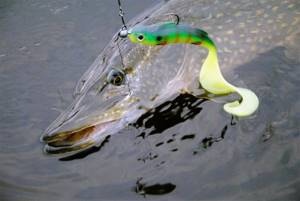
In the pre-spawning period, pike prefer large and even very large silicone baits, while after spawning the baits should be small. This applies to both jig fishing in deep water and fishing in shallow water.
For catching perch, the optimal fishing method in the spring is microjig. Both the mass of the head and the size of the bait should be small.
Wobblers
In spring, pike are mainly caught in shallow water using wobblers. During the pre-spawning period, large minnow wobblers with active play, crankbaits and jerkbaits are used, and when the spawning ends, better results can be achieved with minnow wobblers that have sluggish play.
Oscillating spoons
Oscillating spoons can be effective when fishing for pike: wide and light when fishing in shallow water and compact when fishing in depth and current. In thickets of last year's grass, non-snacking spoons can help achieve good results.
